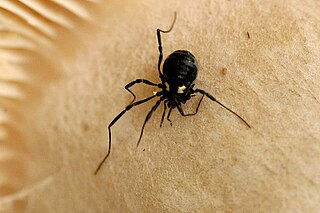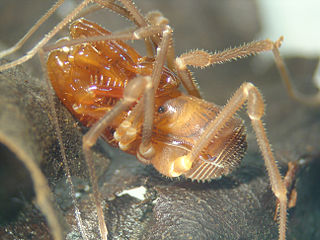Related Research Articles

The Opiliones are an order of arachnids colloquially known as harvestmen, harvesters, or daddy longlegs. As of April 2017, over 6,650 species of harvestmen have been discovered worldwide, although the total number of extant species may exceed 10,000. The order Opiliones includes five suborders: Cyphophthalmi, Eupnoi, Dyspnoi, Laniatores, and Tetrophthalmi, which were named in 2014.

Pachylinae is the most diverse subfamily of the harvestman family Gonyleptidae, including around 400 valid species. Major groups of species occur in the Brazilian Atlantic forest, Bolivian/Peruvian highlands, Argentina and Chilean temperate forest.

Samooidea is a large superfamily in the Grassatores group of harvestmen. It includes around 380 species distributed throughout the tropics. They are characterized by the complex male genitalia, with eversible complementary sclerites.

The Nemastomatidae are a family of harvestmen with about 170 described species in 16 recent genera. Several fossil species and genera are known.
The Stygnopsidae are a small family of harvestmen, with almost all species found in Mexico.
The Stygnidae are a family of neotropical harvestmen within the suborder Laniatores.
Agoristenidae are a neotropical harvestman family of the Suborder Laniatores, in the superfamily Gonyleptoidea.
The Manaosbiidae are a family of neotropical harvestmen within the suborder Laniatores.

The Cranaidae are a family of neotropical harvestmen within the suborder Laniatores.

Stygnommatidae is a small neotropical family of the harvestman infraorder Grassatores with about thirty described species.

Samoidae is a family of the harvestman infraorder Grassatores with about fifty described species.
Biantidae is a family of the harvestman infraorder Grassatores with about 130 described species.

Podoctidae is a family of the harvestman infraorder Grassatores with about 130 described species.
Stygnomma is a genus of armoured harvestmen in the family Stygnommatidae. There are more than 30 described species in Stygnomma.
Taito is a genus of harvestmen in the family Cosmetidae. The genus is endemic to the Amazon Basin in Brazil, Colombia, Ecuador and Peru.
References
- Joel Hallan's Biology Catalog: Minuidae
- Kury, Adriano B., 2003. Annotated catalogue of the Laniatores of the New World (Arachnida, Opiliones). Revista Ibérica de Aracnología , vol. especial monográfico 1: 1-337.
- Pinto-da-Rocha, R., Machado, G. & Giribet, G. (eds.) (2007): Harvestmen - The Biology of Opiliones. Harvard University Press ISBN 0-674-02343-9